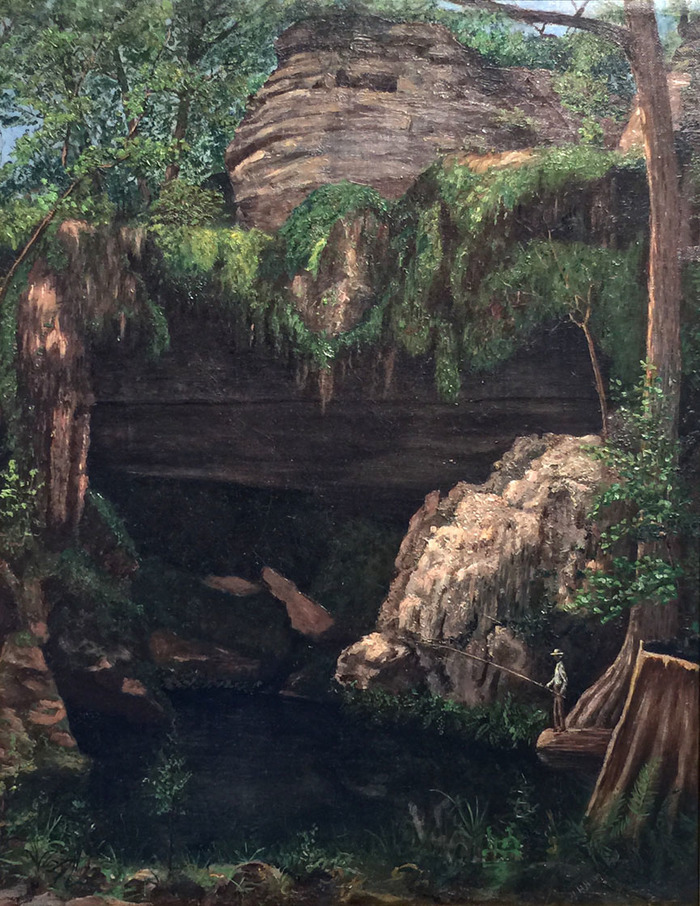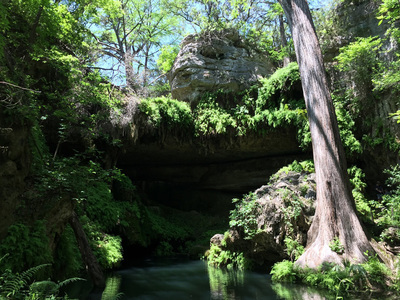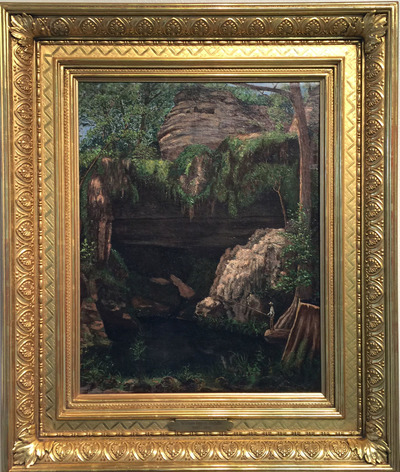William Henry Huddle "Westcave, Hamilton Pool"
-
- William Henry Huddle
- 1847-1892
- Austin Artist
- Image Size: 19.5 x 15.5
- Frame Size: 28 x 23.5
- Medium: Oil
- Circa late 1870s
- "Westcave, Hamilton Pool"
- Contact for Price & Info
- View All By This Artist
Details
Westcave looks almost exactly the same today as it did in this painting. You will notice the difference in size of the tree to the right of the work is substantially larger today after almost 140 years.
The fisherman in the painting is possibly Karl Lungkwitz. He and Huddle were good friends and traveled the old Hamilton Pool Rd which was the old road to Fredericksburg where Lungkwitz most likely still had family. -
-
Biography
William Henry Huddle 1847-1892
The following biography is based on a draft of a
manuscript titled WILLIAM HENRY HUDDLE, HIS FRIENDS AND CLASSMATES, by
Skipper Steely of Paris, Texas:
Over 700 visitors per day walk
into the Texas Capitols south entrance in Austin, look to the left, and
are struck by the huge William Henry Huddle "Surrender of Santa Anna"
painting. To the right is a large portrait of Alamo defender Davey
Crockett, also by Huddle. In fact, as guests roam the Texas pink granite
building, they see twenty-nine other works by Huddle hung on the walls.
Up and then around the rotunda are a set of the Republic of
Texas presidents, and the first 17 governors who served after the
country was annexed into the Union in 1846. The House and Senate
chambers also have paintings by him as does the Secretary of States
office and the law library.
Who is this artist, and just why
does he so dominate the inventory in the old building? In addition, four
of his works hang across the street in the Governors Mansion. He has
had works on the University of Texas campus located at the Harry Ransom
Center.
His works are not acclaimed by teachers, instructors or
art lovers in Austin or on the nearby University of Texas campus. In
fact, in 1997, after reading over a rough manuscript on this late
Virginian turned Texan, a reviewer said ". . . Huddle was not a very
good artist . . ." The comments continued into a series of questions:
What was his vision? What was he trying to do? Did he accomplish it? Did
he glorify successfully the history of Texas?
The answers are
elusive as no letters or memoirs relate his first hand thoughts on those
questions. But, after years of study about his life, it appears to me
his art quality does not seem the most exciting thing about his
contribution. His style was fairly realistic, clear and simple to
understand, and appealing to many other artist contemporaries who,
although they enjoyed art, were basically attempting to earn a living
through their talent.
In Huddles case, he was an enjoyable,
rowdy member of Austins society, with a passion to paint. His most
frequent subjects were people, but occasionally he went to the hills and
did landscapes.
The reviewers comments concluded, "You can do
nothing about the quality of Huddles work, but that does not diminish
its importance to Texas history." As for his dominance over other fine
artists who wanted their work purchased by some governmental entity, it
was luck and whom he knew that caused the capitol projects to fall onto
Huddles easel. Huddle won the contract more likely because he had made
friends in Austin who had the right contacts, while fierce competitors
Henry McArdle and Robert Onderdonk did not have those extensive
contacts.
The first capitol building burned down in 1880 while
Huddle was in the initial stages of his research of Republic of Texas
presidents and governors. When the rebuilding committee decided to
construct with Texas pink granite instead of sand stone, the decision
was to hang more paintings and have fewer sculptures than originally
planned.
In his personal life, Huddle enjoyed drinking, talking
and partying and was more "manly" than many of his artist peers, being
large, an expert shot, and not afraid to stand his ground in any
discussion. Still, his work is not crude. It was trained both by study
along side his cousin, Philadelphia-trained Flavius Josephus Fisher of
Lynchburg and Richmond, Virginia, and by the better part of three years
spent in New York City. After the Civil War he spent three years with
Fisher in Lynchburg, Virginia, and then three with his parents and
relatives in Paris, Texas, before heading east.
Gunsmithing and
working with jewelry were professions of his family, and he worked at
this when artistry did not get in the way! A Lynchburg fire destroyed
all his past work left in Fishers studio, but he did bring to Texas with
him a self portrait done with Fishers dog. He began to earn money by
painting portraits of the many Texas history figures in Paris. For
instance, three of the eight 1861 Secession Convention members who voted
not to leave the Union lived in Paris. Other Civil War figures were in
the city, and one man who dodged death at the massacre of Goliad was a
subject.
Gathering up a substantial amount of financial support
from Parisians, Huddle entered the world of "real" artistry by enrolling
in the National Academy of Design in New York City. His first class
began October 26, 1874. Around him were future artists whose names
quickly bring up samples of their works on the internet. They comprise a
nice role of "Whos Was Who" of American art of that time and include
the President of the NAD in 1874, Thomas Worthington Whittredge, a
veteran of three trips to the far west to sketch work possibilities.
Huddle
enrolled into both the antique and life classes, but little did he
realize that the NAD was in dire financial straits, a condition that
would split the training artists and teachers in less than eight months.
During his first year at the NAD Huddle studied with Walter Shirlaw and
the instructor, Lemuel Wilmarth, the first paid teacher at the NAD.
When
NAD classes closed in May of 1875, about 70 students met with Wilmarth
at his Tenth Street Studio Building location. On May 24, the group
decided to create a fee-oriented Arts Students League, but Wilmarth
would not receive pay. The ASL would be run by students, unlike the NADs
long tradition of being teacher dominated.
Huddle apparently
remained with the NAD that fall, but signed on with the ASL December 2,
1875 and was in classes by that February. By the next fall 135 students
were crowding the quickly expanding facilities. Most likely Huddle
remained through the spring session of 1876-77, because the Austin
"American Statesman" referred to him moving to central Texas by June 19,
1877.
Huddle died just as he was preparing an exhibit of
several works for the Chicago Worlds Columbian Exposition in the spring
of 1893. His chance to widen an appeal for his work vanished.
While
Huddle today is not considered an artist of note, a writer for the
"Austin Statesman" in September of 1877 was excited about the the
"exceptional" artist in town. His article stated that Huddles portrait
of Governor Hubbard, on display at a local bookstore, ". . . is no
blackwood daub in charcoal or pretty whitewashed picture; but the very
man himself." Indeed, Huddle had his fans!
Huddle, William Henry. 1847-92. Paris, Austin. Portrait and historical-scene painter.
Born in Wytheville, Virginia, Huddle attended school there and in Tennessee. He Served as a Confederate cavalryman for two years and came to Texas in 1866 when his family settled in Paris. While working as a gunsmith, Huddle studied art locally, then moved in 1870 to Nashville, Tennessee, to study under his cousin, Flavius J. Fisher, who had painted portraits of prominent individuals in Washington, D.C., while working there before the war. About 1874 Huddle began to study at the National Academy of Design, New York, but withdrew and helped establish the Art Students League of New York, along with Henry Arthur McArdle and Robert Jenkins Onderdonk. In 1876 Huddle moved to Austin where he taught at St. Mary's Academy, followed by a stay in Europe when he studied portrait painting at the Royal Bavarian Academy, Munich (1884-86).
Many of Huddle's paintings were done after his return to Austin in 1886, including a series of twenty-three portraits. They were purchased for $8,000 by the State of Texas out of a $10,000 appropriation to obtain paintings and statuary for the present capital, completed in May 1888. Many of the portraits were done from faded photographs. Huddle was commissioned to paint a life-size portrait of General Thomas Jefferson Rusk, signer of the Texas Declaration of Independence, chief justice of the Texas Supreme Court, and a U.S. senator. The remaining portraits were those of the five presidents of the Republic of Texas (Henry Smith, David G. Burnet, Sam Houston, Mirabeau B. Lamar, and Anson Jones) and the seventeen governors who held office between 1836 and 1888 (J.P. Henderson, George F. Wood, Peter H. Bell, Elisha M. Pease, Harding R. Runnels, Edward C. Clark, Francis R. Lubbock, Pendleton Murrah, James Wilson Henderson, Andrew Jackson Hamilton, James W. Throckmorton, Edmund J. Davis, Richard Coke, Richard B. Hubbard, Oran M. Roberts, John Ireland, and Lawrence S. Ross). The works presently Hang in the Capital. The state also purchased Huddle's portraits of Governor James S. Hogg, Judge Alexander W. Terrell, Colonel David Crockett, the impresario Sterling C. Robertson, and Huddle's large canvas portraying the surrender of Santa Anna to General Sam Houston after the Battle of San Jacinto. The painting depicts numerous historical figures associated with the surrender, the likenesses of many having been taken from dim daguerreotypes. The canvas presently hangs in the south entrance hall of the capital. Biesele attributes to Hermann Lungkwitz the "landscapes" in the painting of Santa Anna's surrender as well as the portrait of David Crockett. Huddle also painted from life a portrait of Senora Andrea Castanon de Villanueva Candelaria, who survived the battle of the Alamo. She was 106 years old at the time of the portrait. Huddle died in Austin following a stroke. His wife was Nannie Zenobia Carver Huddle, a former St. Mary's student whom he married in 1889.
Exhibitions: A Century of Art and Life in Texas, Dallas Museum of Fine Arts (1961); Painting in Texas: The Nineteenth Century, Amon Carter Museum of Western Art, Fort Worth (1967).
Collections: Capital Historical Artifact Collection (thirty-one paintings) and Governor's Mansion, Austin; Dallas Museum of Art.



